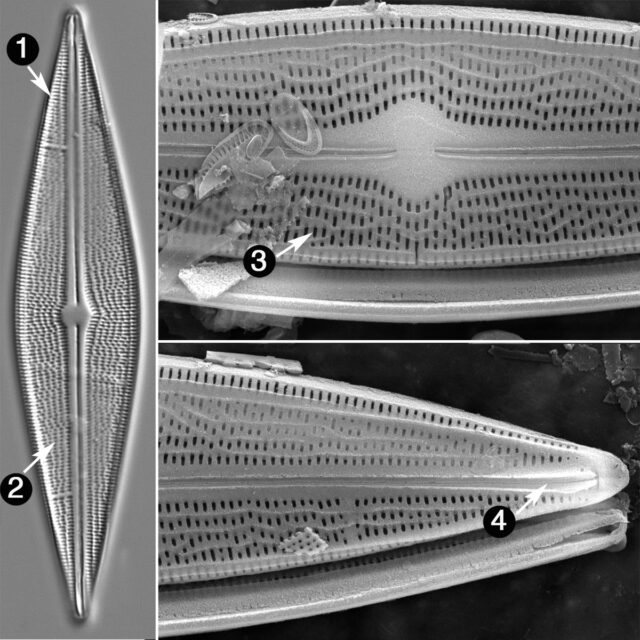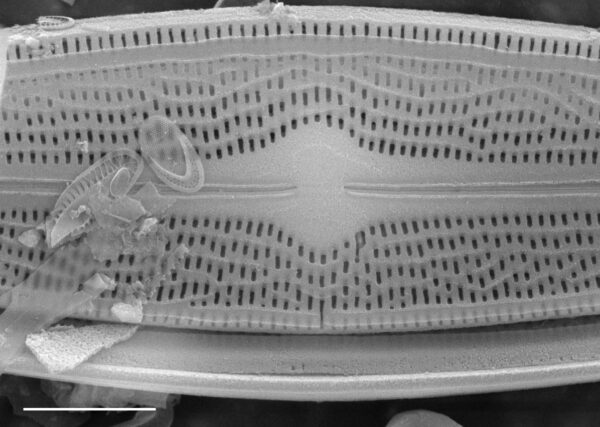Brachysira serians
-
Category
-
Length Range50-123 µm
-
Width Range14-19 µm
-
Striae in 10 µm18-23
-
SynonymsAnomoeoneis serians (Bréb.) Cleve
Navicula serians Bréb. ex Kütz.
-
ContributorPaul Hamilton - Dec 2010
-
ReviewerSarah Spaulding - Feb 2011
Identification
Description
Valves are lanceolate with narrowly rounded apices. The striae are slightly radiate to parallel throughout the valve. At the apices, the striae are composed of a single areola. The axial area is linear and distinct; the central area is asymmetrically rounded. The raphe is positioned between two external, longitudinal ribs. The raphe is straight with straight proximal fissures and T-shaped distal fissures. Areolae are elongated rectangular slits with rounded ends, oriented to the transapical axis. Spaces between the areolae give the appearance of longitudinal undulations. Thick, external ribs are present at the valve margins. The mantle possesses a single row of elongated areolae. One or two Voigt faults are present on the secondary side of the axial area.
In SEM, the internal distal raphe fissures terminate at small helictoglossae. The areolae are covered internally with flat hymenes. Externally, a series of siliceous ridges may extend longitudinally on the valve face.
The first description of B. serians appeared in Kützing (1844), with a valve length of 94 µm. Kützing's illustration (Taf. 30, fig. 23) presents the species in valve and girdle views.
The images presented here are not consistent with the type of Kützing (Van de Vijver et al. 2022). This page may be updated in the future.
Autecology
Brachysira serians was reported in acidic and humic stained waterbodies of the eastern United States, but in abundances less than 10% (Siver et al. 2005; Siver and Hamilton, 2011). A preference for acidic habitats was also noted by other authors (Patrick and Reimer, 1966; Lange-Bertalot and Moser, 1994; Camburn and Charles, 2000; Gaiser and Johansen, 2000). Optima for pH and TP from these works range between 4.0-5.2 and 4.3-15.6 µg/L, respectively.
-
Size Range, µm3
-
Motility
-
Attachment
-
Habitat
-
Colony
-
Waterbody
-
Distribution
- Learn more about this
Citations & Links
Citations
-
Publication Link: 10.1080/0269249X.2000.9705487
-
Publication Link: 10.1080/23818107.2021.1941250
Links
-
Index Nominum Algarum
-
North American Diatom Ecological DatabaseNADED ID: 18003
Cite This Page
Hamilton, P. (2010). Brachysira serians. In Diatoms of North America. Retrieved November 21, 2024, from https://diatoms.org/species/brachysira_serians
Responses
The 15 response plots show an environmental variable (x axis) against the relative abundance (y axis) of Brachysira serians from all the stream reaches where it was present. Note that the relative abundance scale is the same on each plot. Explanation of each environmental variable and units are as follows:
ELEVATION = stream reach elevation (meters)
STRAHLER = distribution plot of the Strahler Stream Order
SLOPE = stream reach gradient (degrees)
W1_HALL = an index that is a measure of streamside (riparian) human activity that ranges from 0 - 10, with a value of 0 indicating of minimal disturbance to a value of 10 indicating severe disturbance.
PHSTVL = pH measured in a sealed syringe sample (pH units)
log_COND = log concentration of specific conductivity (µS/cm)
log_PTL = log concentration of total phosphorus (µg/L)
log_NO3 = log concentration of nitrate (µeq/L)
log_DOC = log concentration of dissolved organic carbon (mg/L)
log_SIO2 = log concentration of silicon (mg/L)
log_NA = log concentration of sodium (µeq/L)
log_HCO3 = log concentration of the bicarbonate ion (µeq/L)
EMBED = percent of the stream substrate that is embedded by sand and fine sediment
log_TURBIDITY = log of turbidity, a measure of cloudiness of water, in nephelometric turbidity units (NTU).
DISTOT = an index of total human disturbance in the watershed that ranges from 1 - 100, with a value of 0 indicating of minimal disturbance to a value of 100 indicating severe disturbance.

Brachysira serians
- Valves lanceolate
- Striae slightly radiate to parallel
- Central area asymmetrically rounded
- Raphe straight at distal valve
Valves are lanceolate. The striae are slightly radiate to parallel. The axial area is linear and distinct. The central area is asymmetrically rounded. The raphe is positioned between two external longitudinal ribs. The raphe is straight with undifferentiated proximal fissures and deflexed T-shaped distal fissures. Areolae are...
 Diatoms of North America
Diatoms of North America






